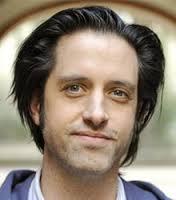|
Back
The Jumping, Running, Standing Still Concert New York
Miller Theater, Columbia University
09/17/2015 -
Simon Steen-Andersen: Run Time Error, Version 1 – Study for String Instrument Numbers 1, 2, 3 – Obstruction Study Numbers 1, 2, 3 – Half a Bit of Nothing Integrated – String Quartet Number 2 – Run Time Error, Version 2 (World Premiere)
Simon Steen-Andersen (Computers), JACK Quartet: Christopher Otto, Ari Streisfield (Violins), John Pickford Richards (Viola), Kevin McFarland (Cello)

S. Steen-Andersen (© 5against4.com)
Reporting last night’s Miller Theater Opening Night concert to a musically conservative friend, I described the tricky projections, the bows made of metal and tape and velcro, the obstruction of white light, and rubber bands and weights, the various squeaks and squawks made by composer Simon Steen Andersen, his videos, joysticks and the JACK Quartet. And expected her to say her usual, “Well, I’m happy not to have been there.”
Instead, she gasped out, “That sounded like a lot of fun.”
And she was right. Just as Mozart and Liszt would show off, as Beethoven would roar with pleasure after playing a piano adagio, it sounds like the famed Danish composer works with physical delectation.
He is a man of the world. He takes every possible sound in the world–cans and water and paper being squooshed, metal pipes, plastic bottles–captures them with video and mike. And then, as he did in the videos which opened the closed the concert, he projected them on the Miller Theater split screen. And he then manipulated each of the two “inventions”, reversing, changing tempos, putting one screen cockeyed against the other.
Both the peripatetic composer and his objects on the screen reminded me or the most iconic original video, the half-century old Richard Lester Running, Jumping, Standing Still movie. Mr. Steen-Andersen’s running, jumping, travels back and forth, quicker and slower. In the words of annotator Paul Griffiths, his video exemplifies “the classical techniques of imitation, augmentation and retrogradation…on the visual and aural plane.”
The musical techniques may sound ponderous, but these, in my friend’s words, were “a lot of fun.” It was pulsing with life, energy and surprises.
These, though, were the bookends of eight connected equally surprising pieces connecting the computer workouts with the knockout, physically mad music of the JACK Quartet.

JACK Quartet (© Sam Von Dogenstein)
Whenever I come upon them in New York, the world becomes a place of quanta and cosmoses. On the one hand, they are able to do anything. On the other hand, they actually do everything.
Though in this case, the “two hands” became tools in the mind of Mr. Steen- Andersen.
In place of a coitus interruptus, Mr. Steen-Andersen gave them a Schumann String Quartet obstructionist. How do you play the opening movement with the ends of bows restrained by rubber bands and weights on the arms? (As they say about the porcupine riddle, “With great difficulty.”) How do they play the second movement with white noise in their headphones and disobliging lighting changes? Or the adagio with prepared bows?
The sounds were agonizing. Robert Schumann–whose own fingers were “obstructed” because a machine he used to “strengthen’ them failed–would not have been amused. On the other hand, a composer like György Ligeti would have relished the originality, the challenges and the joy of the inventions.
A few of the pieces were were talisthmatically mesmerizing. In Study for String Instrument (with a written Zen-style motto, “Movement of the sound or sound of the movement”), the four members of the JACK Quartet play one sound over and over, atomizing the functions, splitting the atoms by doing what only strings (and clarinet) can accomplish. By endless glissandi, the hands manage to theoretically bring in every possible interval.
In an even more magical–and tricky–piece, cellist Kevin McFarland sits in front of a small screen performing relatively conservative music. On the stage to his side, though, composer Simon Steen Andersen is operating a computer which duplicates Mr. McFarland’s hands, in different directions even as he is performing.
In another guise this would be called performance magic–the hands being quicker than the eyes!! But with this sophisticated audience, ready to pick up the most minor parodies of string playing, it became a terrific concert piece.
So many changes took place with each work–going from strobe lighting to video “selfies” to transmogrifications of the instruments, that one could rarely be bored. The one exception was the Second String Quartet, fourteen minutes where the composer’s notes were more interesting than the musical notes. “The quartet shifts the perspective from the body of the instruments and the left hand actions to the right-arm movements…getting closer to the friction of the bow…the actual hairs of the bows are partly masked with tape...”
Etc etc. Fascinating reading, wonderful in theory to hear the whispers, the pulses, the sonorities, the voices...
But I guess Philistines like myself wanted more action, more video, more tricks. Hopefully I will be forgiven.
As for the JACK Quartet, they can do no wrong. Tonight I will be hearing a new work by Georg Friedrich Haas. The first time I heard this composer, it was the JACK Quartet doing the honors. And no matter how good Mr. Haas may be tonight, memories always return to these four artists.
The usual cliché with great player is that they make the most difficult music sound easy. Not true here. Mr. Steen-Andersen’s music sounded difficult (especially with weights on the arms!), it had a relationship more with the Music of the Spheres than the sounds of the concert hall. Yet its dizzying transformations brought us closer to music’s aether, and, in its own quirky operating modes, to its very essence.
Harry Rolnick
|